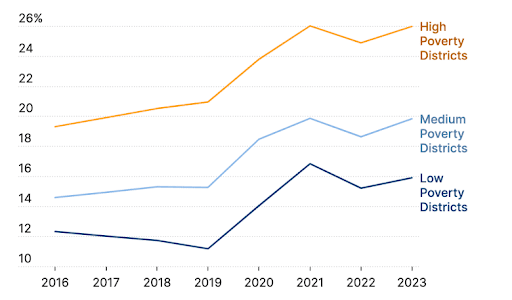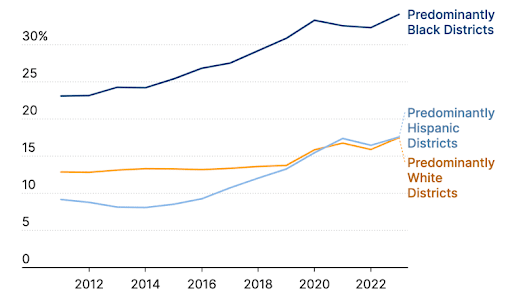Resource: Brookings, “Decreasing public college registration,” August 2025
Independent school registration flat
Prior to the pandemic, the share of students in typical public colleges held constant, floating near 85 percent in between 2016 and 2020 After the pandemic, standard public institution registration plummeted to listed below 80 percent and hasn’t rebounded.
The mysterious absent kids make up a big chunk of the decline. Yet households also changed to charter and digital schools. Charter institution registration increased from 5 percent of students in 2016 – 17 to 6 percent in 2023 – 24 The number of kids going to virtual schools nearly doubled from 0. 7 percent before the pandemic in 2019 – 20 to 1 2 percent in 2020 – 21 and has stayed elevated.
Surprisingly, private school enrollment has stayed consistent at almost 9 percent of school-age kids in between 2016 – 17 and 2023 – 24, according to this Brookings quote.
I had actually expected independent school enrollment to increase, as family members soured on public school interruptions during the pandemic, and as 11 states, including Arizona and Florida, launched their own academic interest-bearing account or new coupon programs to help pay the tuition. But one more evaluation , released this month by researchers at Tulane University, resembled the Brookings numbers. It found that independent school enrollments had enhanced by just 3 to 4 percent between 2021 and 2024, contrasted to states without coupons. A brand-new government tax credit history to money independent school scholarships is still more than a year away from entering into effect on Jan. 1, 2027, and possibly a greater shift right into private education is still ahead.
Defections from conventional public schools are biggest in Black and high-poverty areas
I would certainly have guessed that wealthier families that can pay for independent school tuition would be more probable to look for choices. However high-poverty districts had the biggest share of trainees outside the traditional public-school industry. In addition to independent school, they were registered in charters, virtual institutions, specialized schools for trainees with specials needs or various other different schools, or were homeschooling.
Greater than 1 in 4 trainees in high-poverty districts aren’t registered in a traditional public college, compared with 1 in 6 students in low-poverty institution areas. The steepest public college registration losses are focused in predominantly Black school areas. A 3rd of trainees in predominantly Black districts are not in traditional public institutions, double the share of white and Hispanic pupils.
Share of student enrollment outside of conventional public colleges, by area destitution

Source: Brookings, “Decreasing public school enrollment,” August 2025
Share of students not enlisted in typical public institutions by race and ethnicity

Resource: Brookings, “Declining public college enrollment,” August 2025
These discrepancies matter for the students that continue to be in typical public colleges. Institutions in low-income and Black areas are now shedding one of the most pupils, requiring also steeper budget cuts.
The market timebomb
Before the pandemic, united state schools were already headed for a huge tightening. The typical American female is now giving birth to just 1 7 youngsters over her life time, well below the 2 1 fertility price required to replace the populace. Fertility rates are forecasted to drop further still. The Brookings analysts assume more immigrants will certainly continue to enter the country, despite current migration restrictions, yet insufficient to offset the decrease in births.
Even if families go back to their pre-pandemic enrollment patterns, the populace decrease would indicate 2 2 million fewer public institution students by 2050 Yet if moms and dads maintain choosing other type of schools at the pace observed because 2020, conventional public schools can shed as numerous as 8 5 million students, avoiding 43 06 million in 2023 – 24 to as few as 34 57 million by mid-century.
In between trainees gone missing out on, the options some Black family members and family members in high-poverty areas are making and how many children are being birthed, the general public college landscape is moving. Twist up and prepare yourself for mass public college closures
This tale about school registration declines was generated by The Hechinger Report , a nonprofit, independent wire service concentrated on inequality and technology in education. Register for Evidence Things and various other Hechinger newsletters